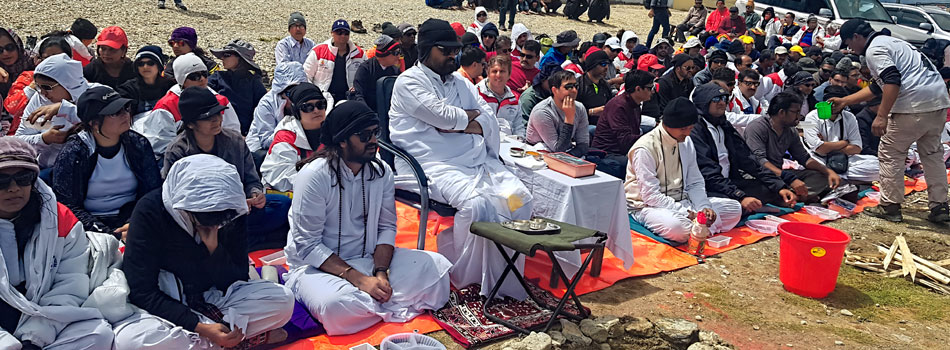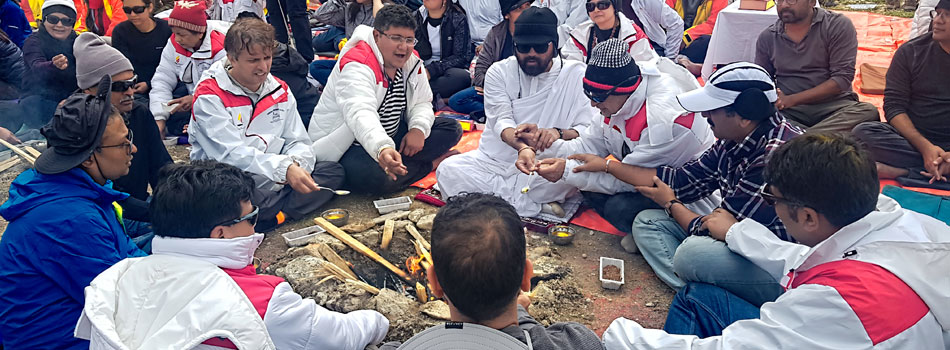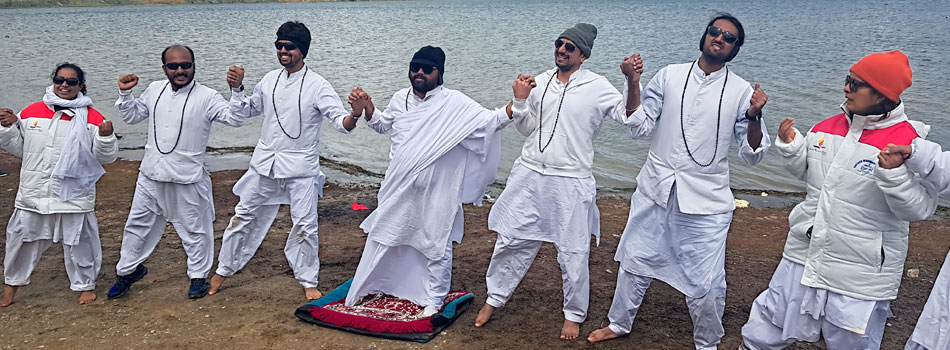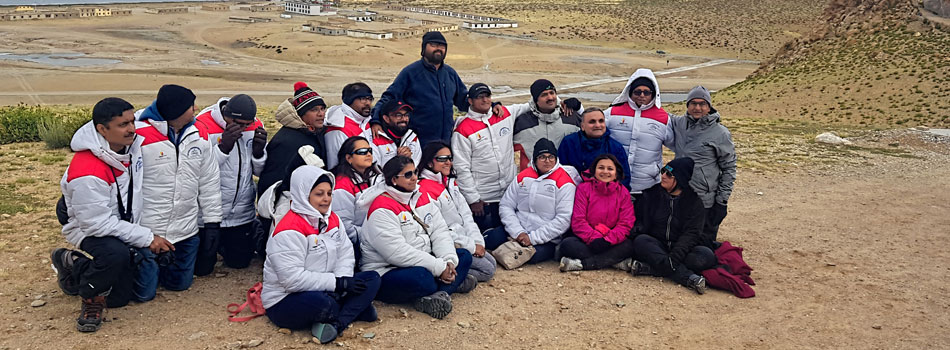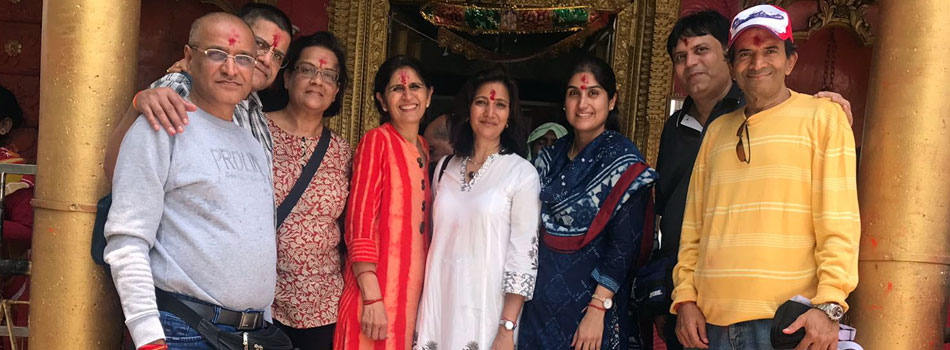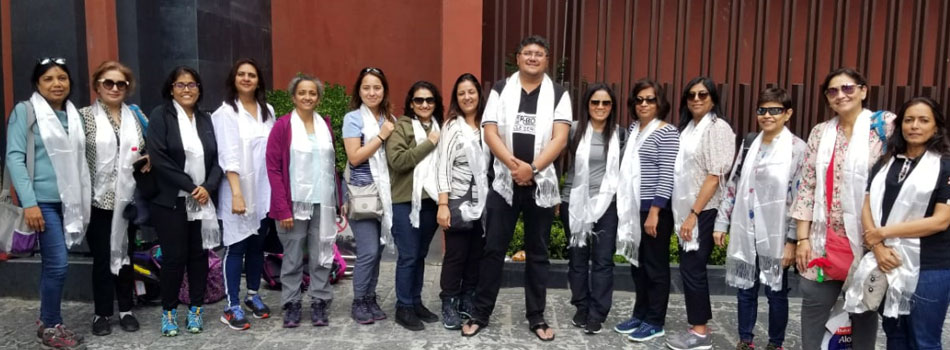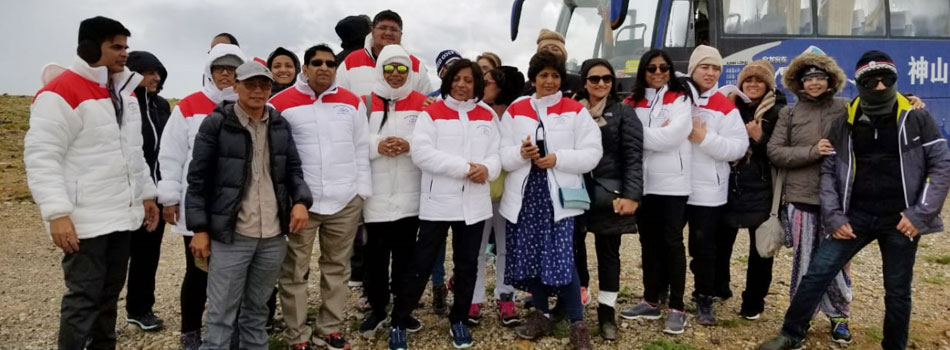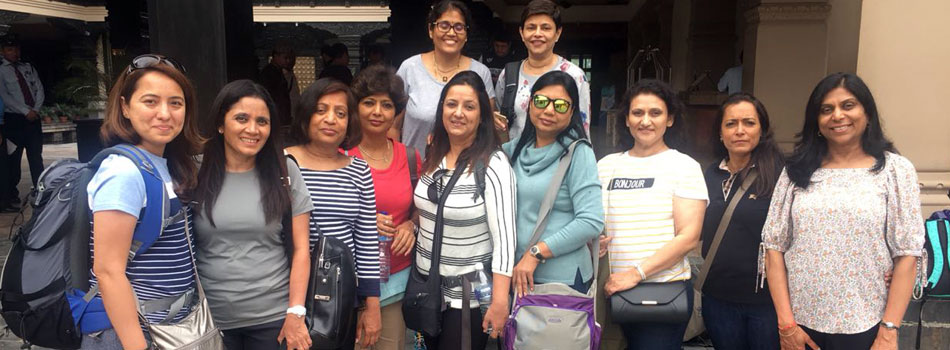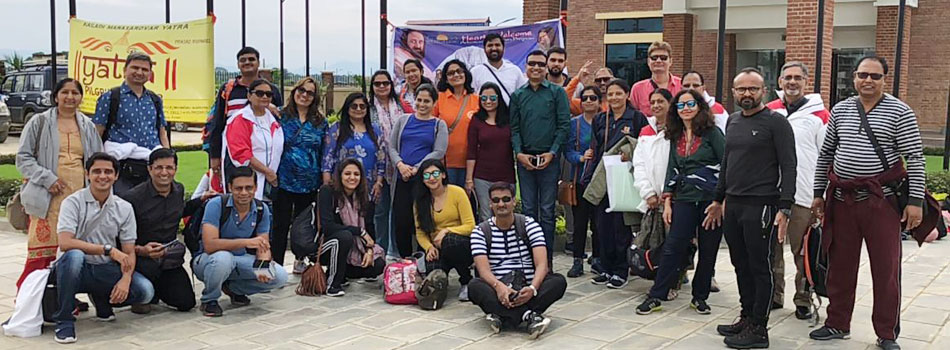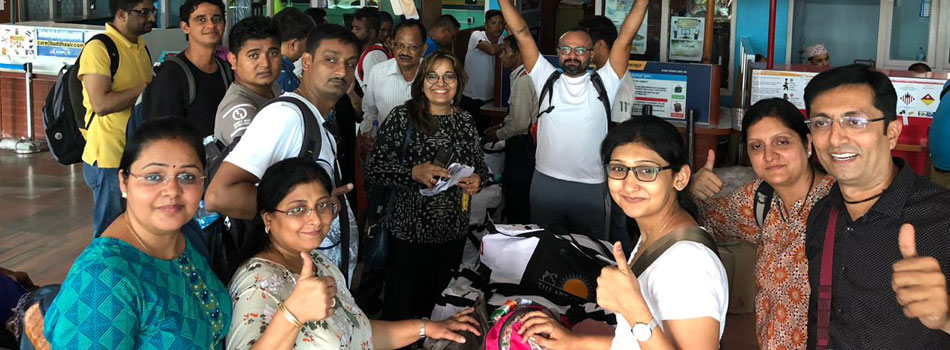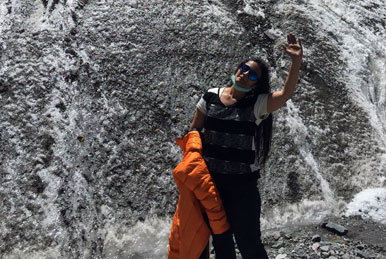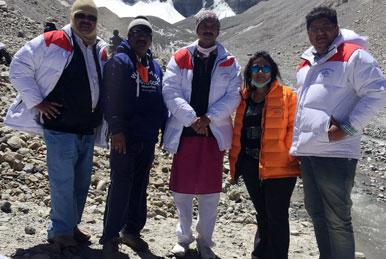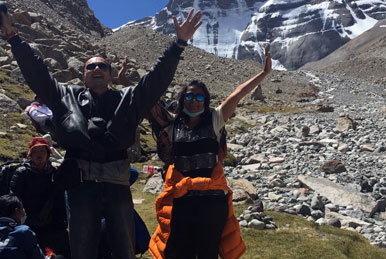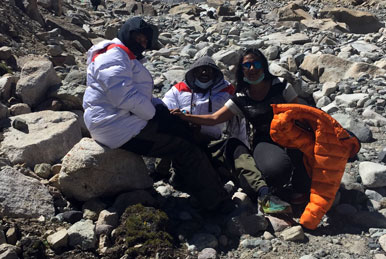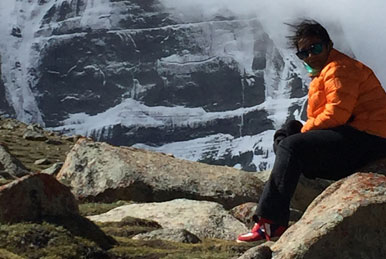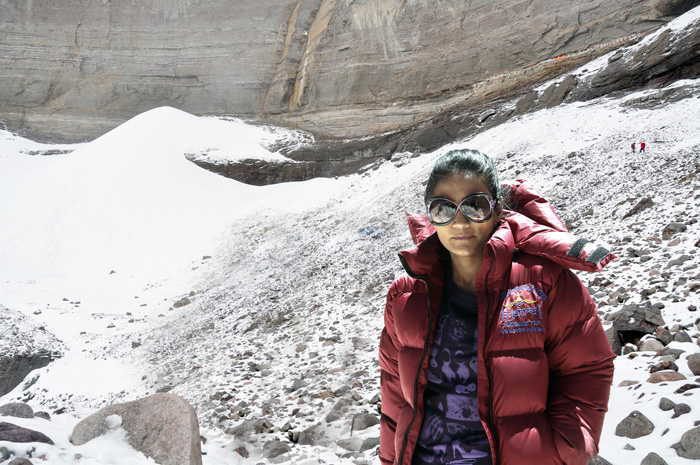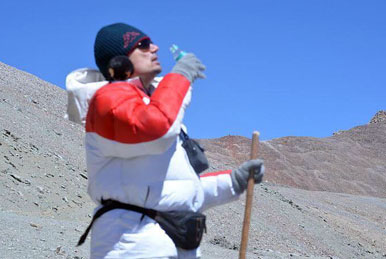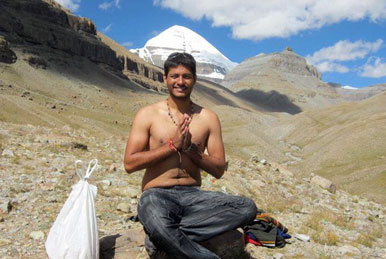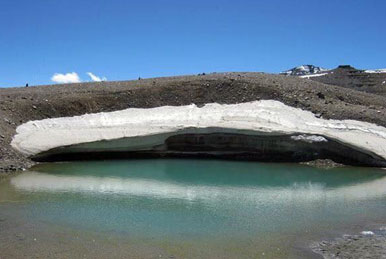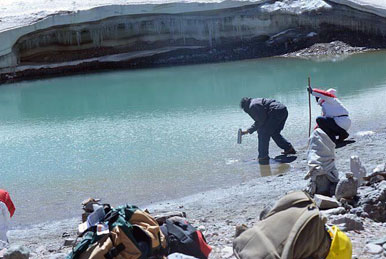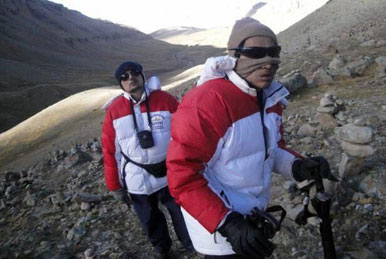Physical Fitness
This is one of the toughest high altitude road journeys on earth. You Must be physically fit - no two ways about that. Generally patients with asthma & heart problems have a problem acclimatizing to high altitudes. In your interests it is essential you should be examined by your doctor to know about your health condition and your ability to cope up with the rigors of high altitude travel for days in 'no road' conditions, extreme cold, dust, trekking to an altitude of 19500ft during the Parikrama, etc.
Although most of the trip will be done in vehicles, it is important that yatris be in relatively good health. The trek around Kailash requires some strenuous hiking and altitude can take a physical toll on the body. We suggest that yatris implement an exercise routine prior to the trip that includes hiking or jogging and yoga for a least an hour 3-4 days a week.If you have any chronic health problems please consult your doctor.
Altitude Sickness
Altitude is a major factor on high altitude Tibet trips. We will often reach altitudes of over 5000m. This can have mild or severe effects on the body no matter what your level of health. Symptoms can include headache, dizziness, nausea, loss of appetite, and difficulty sleeping. The best way to prevent this is to stay extremely hydrated and conscious of how your body is functioning. Do not drink alcohol or smoke prior to and during the tour. We also schedule rest days to help the body acclimatize. There is also prescription altitude medication called Diamox (consult your doctor) that can help prevent symptoms. Be sure each of you are traveling on your own risk. It's recommended to have a file with your medical history on this type of trip with recent medical report.
Visa & Documentation
Yatris must be in possession of a current passport with at least 6 months of validity remaining. The travel agent will take care of all the Chinese visa and entry permit procedures once we send copy of your passport and advance deposit. Indian passport holders do not need visa for Nepal.To get a visa on arrival at the airport/border you need to have 2 copies of recent photograph along with 40.00 USD for 30 days valid multi-entry visa.
Accommodation
While in Nepal Yatris will stay in twin sharing rooms(single rooms available for additional cost) in a good quality hotel in Kathmandu. In Tibet the accommodation will be in decent guest houses with shared rooms and basic toilet facilities (in case of heavy rush and emergency we will use our own tented camp). The staff will attend to all the camping responsibilities.
Food
All meals during the trip will be provided. While in Tibet, delicious vegetarian meals that will include soups, rice, noodles, pasta, pizza, bread, curry, dal (lentils), potatoes, pickle, porridge, tea, milk, coffee will be provided. Stay in Kathmandu hotel will be on full board basis.
Insurance
Proper medical and travel insurance prior to the trip is highly recommended. Make sure travel insurance includes emergency and rescue coverage. Consult your insurance agent for Himalayan Pilgrimage going up to heights of 4500m.
Risks & Liability
The tour company and its associates will put every effort to make your journey smooth and pleasant. However, all the tours in Tibet are conduct strictly under the rules & regulation of Tibet Tourism Bureau (TTB). Therefore, the tour company and its counterpart shall not be responsible for any change and alteration in the program due to unavoidable circumstances such as landslide, road blockage, flood, snow, political unrest, and cancellation of flight, delay arrival, sickness or accidents. Any extra cost incurred thereof shall be borne by the yatri on the spot.
General Guidelines on Packing List
2. One pair of simple tennis shoes. This is back up during 3 days of walking around the mountain. In case it rains we will need extra pair. Also when we start from Kathmandu we can be in these shoes, as hiking shoes are heavy. Hiking shoes are particularly useful for hiking on rough terrain. Can buy in Kathmandu.
3. Walking/hiking sticks. You can get wooden sticks from the tour organizers, but they are not very good for hiking. Collapsible/telescopic poles used by hikers are best suited as they come in pairs to support both sides and also have a small shock absorber at the end. Swiss hiking poles are excellent, but there are plenty other companies too making good telescopic poles whose lengths can be adjusted for individual use. Can buy in Kathmandu.
4. Back pack. We will get one big duffle bag from the tour company for packing our stuff in. We can�t take our suitcases in Tibet; they will be left behind at the hotel in Kathmandu. For our day�s use, as well as during 3 days around Kailash we will be carrying only this back pack with essential stuff (water bottle, medicines, electrolytes, torch, toilet paper, extra pair of inner garments, raincoat/poncho, jumper/sweater, camera, etc). Avoid oversize back packs as it is difficult to carry weight at such high altitude. We will get a backpack free from the travel agency in Kathmandu, which is good enough.
5. Sleeping bag. Usually tour agency will provide with sleeping bag, but if you are fussy about quality then better bring your own, medium size down bags are good. Over this you can put the one from the travel agency. Can buy/rent from Kathmandu.
6. Electrolytes salt/Oral Rehydration salts. Electral powder packs, Indian make, are excellent small size packets for one liter of water. I carried around 20 of these 30gm packets. They are very useful, almost indispensable due to rapid dehydration in high altitude. Can buy in Kathmandu.
7.Torch. Very important! There is no power in most of Tibet. Particularly during our walk around the mountains we will need it. Also most of the places have very bad or no toilet facility. Although we can get toilet tents set up but the best way is using the open fields, believe me its more hygienic that way. LED torch lamps with head strap are useful, but not necessary. Can buy in Kathmandu or even in Tibet at entry point.
8. Water bottles. Carry two one-liter water bottles for the trip. The tour guides carry 20L mineral water jars, we get our bottles refilled from time to time. It is very important to stay hydrated, as that is the best way to keep effects of high altitude under check. I used to carry two bottles and one small half liter bottle. In this small bottle I used to prepare a concentrated solution of Tang powder, electrolyte, common salt and mix it with my plain water (of one liter bottles)to keep salt and glucose level normal/high in my body. Can buy bottles, Tang powder in Kathmandu.
9. Toilet Paper. Very important! The stomach upsets, loose motion, etc is quite common. A lot of stops are made enroute for this. Can buy from Kathmandu and in Tibet.
10. Woolen socks. 2 to 3 pairs. The temperature at night is subzero on Centigrade scale. Can buy in Kathmandu.
11. Cotton socks.3 to 4 pairs. Use cotton socks under the woolen socks. Since there is a rare chance of washing your socks it�s better to carry extra pairs. Can buy in Kathmandu.
12. T-Shirts. 2 to 3, full sleeves cotton. I used one with collars/polo neck to prevent sunburn on the back of the neck. Can buy in Kathmandu or Tibet.
13. Thermal inners. 2 pairs. Buy thermal full sleeve shirt and long jones. Also consider wearing Jeans or nylon snow-pants during Parikrama, they are good insulators from cold. Don�t use very tight jeans, you have to wear thermals inside. Buy in your own country and start using it.
14. Rain suit/poncho with hood. Kailash has micro climate. Weather is unpredictable. Rain suit, shirt and pant separate are a good idea. Or buy poncho raincoat, which can be packed in a very small size. Consider covering the shoes while walking during rain so that you don�t get your feet wet inside. Trick: I carried long plastic bags (one that you get in shopping malls near vegetable stall) and string. My plan was to tie one end over my lower leg with string and let the other open end cover the shoes while walking in the rain. It didn�t rain!
15. Gloves. One inner cotton/woolen/spandex mitten and one proper snow Gloves, waterproof. Can buy in Kathmandu.
16. Woolen cap. Useful to cover the ears. Called Monkey cap in India/Nepal and Balaclava/tuk in west. Can buy in Kathmandu.
17. Waist bag/pouch/pocket. To keep money, pen, passport, torch, small camera, whistle, etc.
18. Thin towel. Called Gamcha in India, this is thin towel, can be also used as scarf to cover head, or tie around waist for bath, they dry quickly and pack in a small space. Can buy in kathmandu.
19. Sun glasses. Good quality with at least 100% UV protection. Invest in a good Sun glass otherwise you run the risk of damaging your eyes due to snow glare and UV light at high altitude.
20. String/Clip to keep the Sunglasses around the neck when not in use. Can buy in Kathmandu.
21. Lighter, Match box, Swiss knife, and miscellaneous items which you feel are necessary. Avoid stuffing your bag with useless items.
22. Underpants and inner Vests. 3 to 4 pair. There will be hardly any possibility of washing your clothes during the trip, so keep some inner garments handy. Can buy in Kathmandu. I carried 5 thin T-Shirts.
23. Medicines (as per your prescriptions) immodium, ibuprofen, paracetamol/Tylenol, pudin hara(Indian-for stomach upsets, indigestion), Sancho(Nepali-for pain in body, cold, headache), pain balm, few Band-Aids, antiseptic cream, etc.
24. Identity card, clip on or neck string type. With complete name, age, address, tel. no, contact details, etc. And one small diary to keep notes.
25. Sun Screen Cream. Good quality, SF above 30. Can buy in Kathmandu.
26. General: Bring long sleeves shirt/kurta. Whatever part is exposed in Sun gets sun-burnt at high altitude, so it is better to cover complete body. Use oversized kurta/shirts as you will put on few layers of T-shirts, vests/thermals inside also. You can buy long sleeves Kurta in Kathmandu also. Ladies should avoid Saris.
27. Nose/face mask. Get the 3 layer surgical mask (normally green in color). This protects from dust, germs and also UV light sun-burns on nose, cheeks. Can buy in Kathmandu.
28. Diamox: the magic pill for high altitude. It is used to prevent or relieve the symptoms of acute mountain sickness in climbers attempting a rapid climb and those who feel sick even though they are making a gradual climb. Its generic name is acetazolamide. We will start taking this pill from Kathmandu itself on and continue for entire trip. Those having HBP and other complications should consult the doctor and check about the dosage. 2 tabs in a day, 250gm strength is normally good. Can buy in Kathmandu.
Essential items : to be kept on one's person at all times
� Important phone numbers/Emergency contact number
� Currency-cash
� Credit/Debit card, Traveler's checks
� Photo ID card with name of tour operator, leader, emergency contact.
� Undergarments
� Night dress
� Thermals
� Full sleeves shirts/Kurta
� Jeans/warm/thick pants
� Sweater
� Fleece jacket
� Swim suit
� Rain Poncho
� Thin towels
� Gloves & Mittens
� Scarves
� Socks
� Hiking shoes
� Light walking shoes
� Sunscreen SPF 30+
� Sunglasses with 100%UV protection.
� Luggage locks
� Luggage name tags
� Photocopy of passport in each piece of luggage with address and contact info.
� Alarm clock
� Torch/Flash light & batteries
� Cameras with extra storage memory cards/batteries
� Few music/audio CDs which you can play in your car in which you will travel.
� Plug adapters ( In Nepal & Tibet the plug is same as Indian)
� Pen and diary/notebook
� Plastic bags to separately pack used and unused dresses.
� Light reading material/book
� Chocolates
� Biscuits, snacks
� Dry fruits
� Chiki (banking on Mumbai/Gujrat group for this!)
� Small towel
� Moisturizing cream
� Cotton buds
� Deodorant (if you are used to it)
� Small mirror
� Tissues
� Wet wipes
� Toilet paper, soap, shampoo, paper soaps
� Safety pins
� Diamox
� Aspirin/Disprin/Pain reliever
� Cold medicine, antihistamine for allergy
� Diarrhea medicine, Immodium, charcoal tablet
� Basic first aid kit
� Plenty of rehydration electrolyte salt sachet
� Glucose powder
� Vitamin pills, multi or C
� Motion sickness tablets
� Paracetemol, tylenol etc
� Cotton
� Throat lozenges
PASHUPATINATH TEMPLE
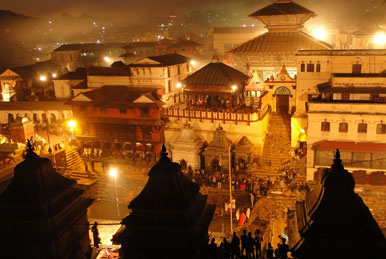


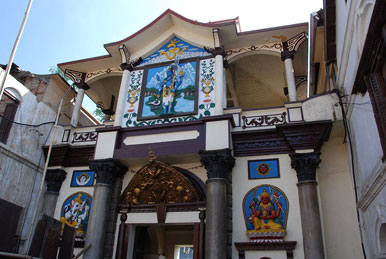
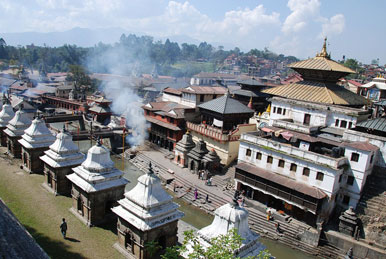
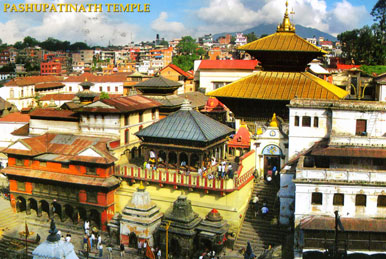
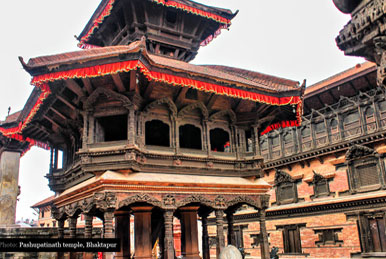







Pashupatinath Temple is one of the most significant Hindu temples of Shiva in the world, located on the banks of the Bagmati River in the eastern part of Kathmandu, the capital of Nepal. The temple serves as the seat of the national deity, Lord Pashupatinath. The temple is listed in UNESCO World Heritage Sites list. The temple is one of the 275 Paadal Petra Sthalams (Holy Abodes of Shiva) on the continent. Over the past times, only born Hindus were allowed to enter the temple. Others could look at it from other side of the river. However, the norms have been relaxed due to many incidents. If the individual is destined, he/she takes and completes the journey to reach these footsteps without any resistance or obstructions along the way, is believed to be under loving grace of Rudra. It is final stage of harsh penance. Thus, the slave (pasu - the human condition) becomes the master (pati - the divine condition). It is regarded as the most sacred among the temples of Shiva (Pashupati). Kotirudra Samhita, Chapter 11 on the Shivalingas of the North, in Shiva Purana mentions this Shivalinga as the bestower of all wishes.
GAURIKUND
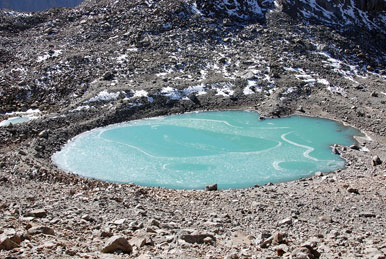
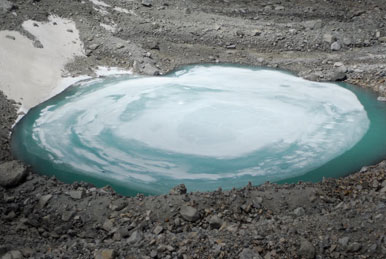
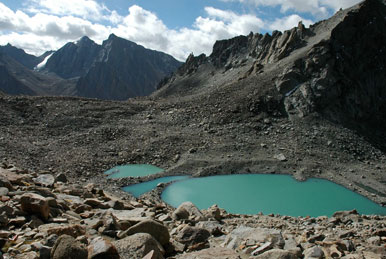

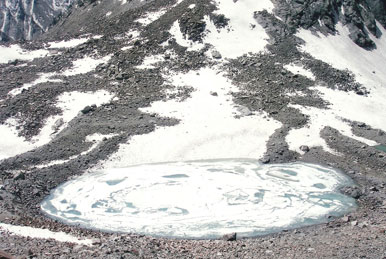
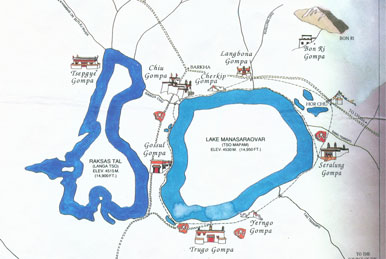
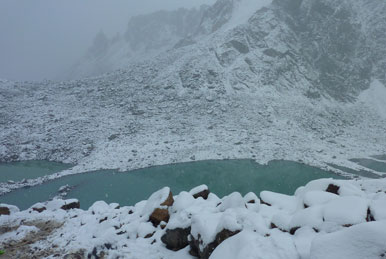







Gauri Kund, a water body that is also known as the Lake of Compassion, lies on the way while Siwasthalgoing on downwards from Dolma - La (Dolma Pass). This steep descent from Dolma Pass is a wonderful lake which is at an altitude of 5608m. As per Hindu mythology, there is a fascinating tale about Gauri Kund and has been described in legend �Shiva Purana�. The lake is also famous as �Parvati Sarovar� as this was the place where goddess Parvati had acquired her son Ganesha (Elephant headed God). Goddess Parvati had formed an image of Ganesh from the soap lather on her body and breathed life into it. She placed Ganesha at the entrance of her home as her janitor to prevent anyone from entering while she was bathing. Now Lord Shiva happened to return at this point of time and was stopped by Ganesha. Offended by this disrespectful act from Ganesha, Lord Shiva cut off the boy's head. Pravati was grief-stricken by seeing it and insisted that the boy needs to be brought back to life. Lord Shiva took the head of a wandering elephant and placed it on the body and life was restored and Parvati had her son back.
RAKSHAS TAL
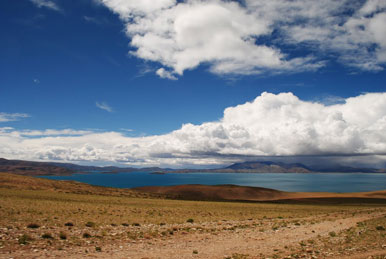
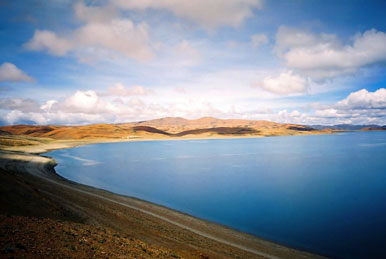
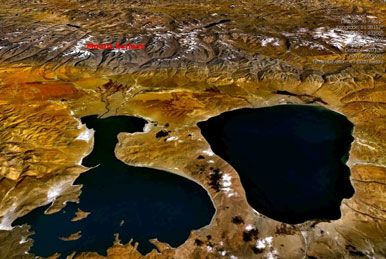
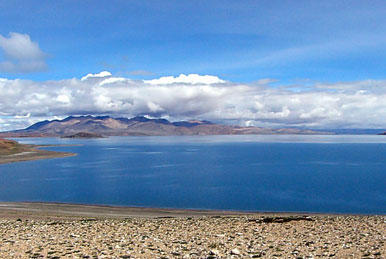










Lake Rakshastal is a lake in Tibet, lying just west of Lake Manasarovar and south of Mount Kailash. [1] The Sutlej River originates at Rakshastal's northwestern tip. Despite its close proximity to Lake Manasarovar (about 3.7 kilometres or 2.3 miles), Lake Rakshastal does not share the historic religious significance of its eastern neighbor.
The name of the lake literally means "lake of the demon" in Sanskrit. It is also known as Ravana Tal, as it is considered to be the place of severe penance by Ravana, the demon-like egoistic King of Lanka in Hindu theology .
[2] In Buddhism, Lake Manasarovar, which is round like the sun, and Rakshastal, shaped as a crescent, are respectively regarded as "brightness" and "darkness". Its salty water, in stark contrast to the fresh water of Lake Manasarovar, results in there being no aquatic plants or fish, and is considered poisonous by locals.
There are four islands in Rakshastal, named Topserma (Dose), Dola (the two biggest), Lachato (Nadzhado), and Dosharba.[3] The islands are used by local people as winter pastures for their yaks.
POOJA AT MANSAROVAR

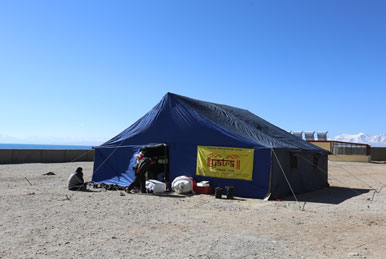












All the yatris wake up early morning and start preparing for the much awaited Homa Puja. In front was the Manasarovar Lake and to the left side we could see Mount Kailash and that was the only mountain to be seen there and to our right was Mount Gurla Mandhatha. The sight was amazing and beautiful so very grand, pristine, and majestic, awe inspiring there HE stood with the blue sky in the background with ITS white peaks. The whole place was so beautiful, serene and peaceful.
YAM DWAR
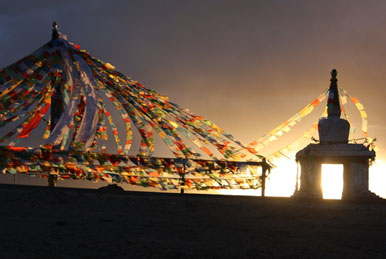
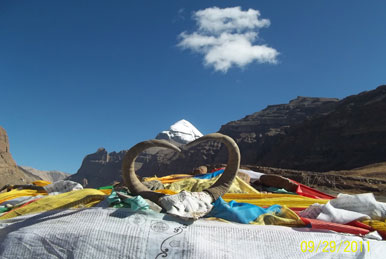
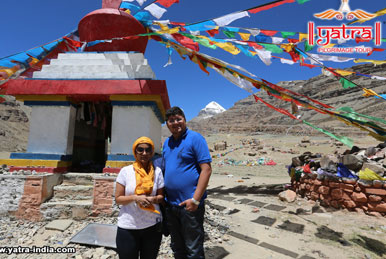
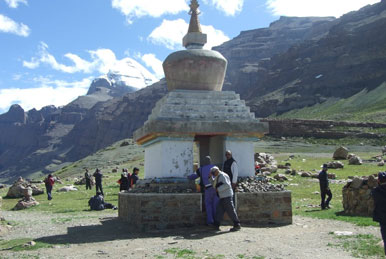
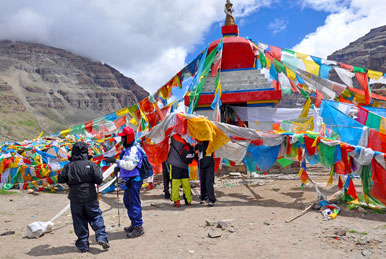









Yam Dwar is situated in Tarboche which is approximately 30 minutes drive from Darchen. The exact meaning of the Yam Dwar in Hindi lingo is �the gateway of the God of Death�. It is the initial point of circumambulation of Mount Kailash. Known as Chorten Kang Ngyi which means two legged Stupa in Tibet.
ASHTAPAD

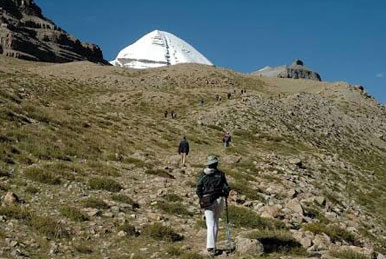
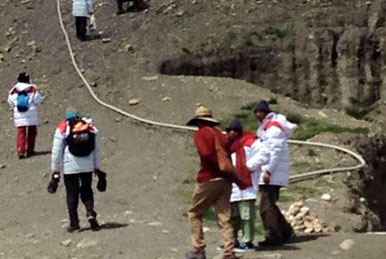
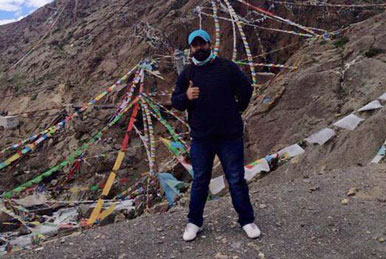


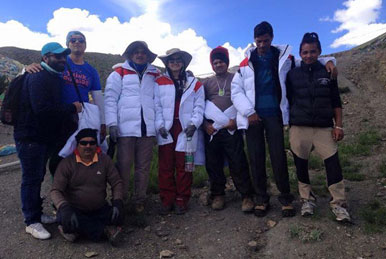









Location at a height of 17000ft, asthapad is the bottom of mt. kailash and one of the main holy places for the hindus and buddhists . It is also considered a major jain tirths as the first of the 24 jain tirthankara "shri adinath bhagwan" had attained salvation (nirvana) at this place. The literal meaning of siwasthal asthapad is "eight steps" as astha means eight and pad means steps in sanskrit and that"s how the place derived its name.
IMPORTANT LOCATIONS









KAILASH MANSAROVAR YATRA
FIND US ON FACEBOOK
VIDEO CHANNEL



